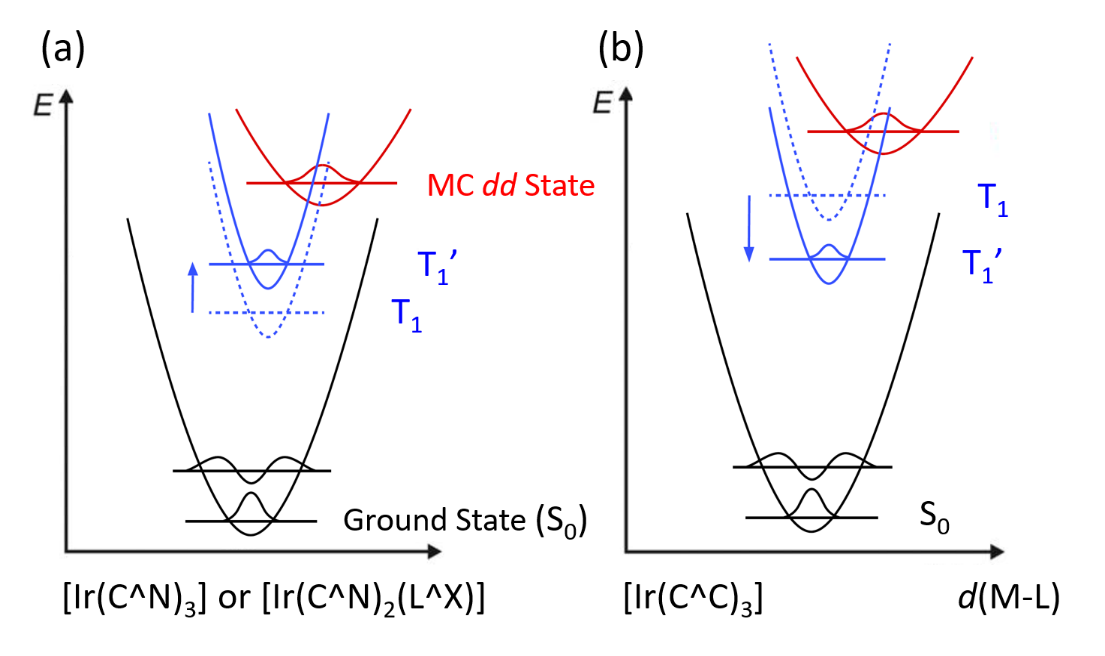

Potential energy surface diagrams for hypothetical Ir(III) complexes with either pyridine-based cyclometalates (C^N) or carbene-based cyclometalates (C^C) and strategical approach in obtaining efficient blue emission for [Ir(C^C)3] emitters, due to the increased energy gap between emissive T1’ state and MC dd excited state.
Opportunity
Organic Light-Emitting Diodes (OLEDs) are used in a display technology based on thin flexible sheets of an organic electroluminescent semiconductor material (light-emitting diodes), sandwiched between layers which serve as cathode and anode, all on a substrate. Unlike conventional LED screens, which use a backlight to illuminate their transmissive pixels, OLED's self-emissive pixels produce their own light when a current is passed through them. Compared with conventional LED displays, OLED displays – used in high-end TVs and smartphones – are thinner and lighter, with higher contrast, a wider viewing angle, and darker (truer) blacks.
Research into OLED technology seeks to develop phosphors – luminescent substances that emit light when excited by radiation – with reduced power consumption, higher performance, a shorter radiative lifetime, and a longer lifespan. While substantial progress towards these goals has been achieved for red and green emitters, the upgrading of blue emitters – the third elementary color – lags behind. The current invention proposes a method for improving the design of blue phosphors to yield greater photoluminescence, enhanced current efficiency, true blue color, and better stability.
Technology
A key objective is to develop blue emitters, which typically have a higher emission energy than red and green, with a shortened radiative lifetime, so that residence time at the highly energized excited states after excitation is shortened, reducing thermally induced decomposition, thereby making the phosphor more stable and robust. Iridium(III) based emitters with N-heterocyclic carbene (NHC) ligands (molecules which bind with a central metal atom to form a chelate) are commonly used. This design proposes the replacement of the traditional design based on three bidentate chelates with a new type of tris-bidentate carbene-based Ir(III) metal complex. This involves the replacement of original benzoimidazolylidene (or imidazolylidene) units with the alternative pyrimidineimidazolylidene and pyrazineimidazolylidene entities. It is expected that, with proper optimization of their photophysical and chemical properties, these newly designed Ir(III) phosphors will display improved emission efficiency, with a wider HOMO-LUMO energy gap, as well as better stability against unwanted degradation of emitters during device operation.
Advantages
- True blue color (current emitters tend towards purple).
- Very high emission efficiencies, requiring lower power consumption.
- Short radiative lifetimes on excitation, expected to offer elongated device stability.
- Narrowed emission band width.
Applications
- All kinds of flat panel displays: television, wall displays, computer monitors, smartphone and game console screens.
- Curved/flexible displays for the above uses and for novel applications to come.
- OLEDs are increasingly being used in home illumination.
- Automotive usage: currently primarily in vehicle tail lights and infotainment displays, but expected to expand to other functions.



